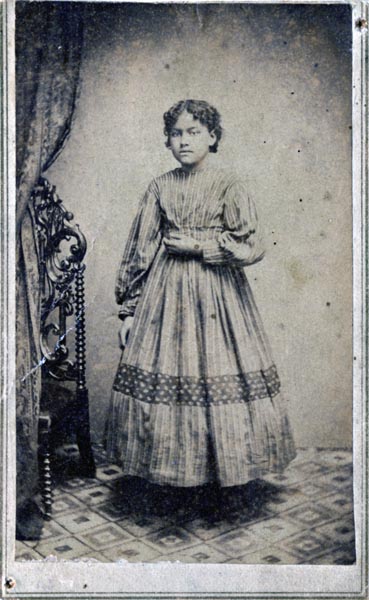Fairmont's Last Living Slave: "Aunt Hat" Wilson Whitely
By M. Raymond Alvarez

Harriet "Little Hat" Wilson, ca. 1861. Photo by H.B. Hull, courtesy of the West Virginia
& Regional History Center, West Virginia University Libraries.
When you’re researching history, you never know what you might find. I first learned about “Aunt Hat” Wilson from a column by Ned Smith in a 1941 Fairmont newspaper. According to Ned, Aunt Hat was supposedly the last person living in Fairmont who was born a slave. I grew more intrigued when I searched the online photograph collection of the West Virginia and Regional History Collection at West Virginia University. I found a photo of a young African-American woman identified as “Harriet, Hattie, Little Hat Wilson Whitely, Slave of Hiram Haymond of Marion County.” With these clues in hand, I started my research journey into the life of Fairmont’s last living slave.
Harriet “Hattie” Wilson came into this world on March 15, 1855, the daughter of Rebecca Wilson, also a slave, in Marion County, which was then part of Virginia. Since Hattie was a slave, her birth wasn’t recorded in public records, and her father’s identity is unknown.
When Hattie was about five years old, she was sold to Hiram Haymond on the steps of the Marion County Courthouse along with her mother, Rebecca (age 34), and older sister, Helen (age 16). There is no documentation on the seller; however, Hiram’s wife, Margaret, was the daughter of a wealthy pioneer in the region named Benjamin Wilson. So, it’s possible that Hattie, Rebecca, and Helen could’ve been owned originally by the Wilson family.
Hiram and Margaret Haymond resided in Palatine, which would become part of Fairmont in 1899. The 1860 census lists him as a “grazier” (farmer) and merchant. By that time, he’d already purchased Hattie, Rebecca, and Helen—the only three slaves he owned. He served in the Virginia General Assembly and was an incorporator of the Fairmont-Palatine Bridge Company, which built the original suspension bridge over the Monongahela River. In 1861, he served as a delegate to the First Constitutional Convention of West Virginia.
By the time of the Civil War, Haymond had amassed considerable debt and was being dogged by creditors. In February 1862—about when the first regular session of the Constitutional Convention adjourned—he abruptly abandoned his property in Marion County and moved to Champaign, Illinois, where he died the following year.
It’s not known what became of Hiram’s slaves after his departure, but they apparently didn’t accompany him to the free state of Illinois. One theory is that Sylvannus Hall, another West Virginia founding father from Fairmont, took possession of Hattie, Rebecca, and Helen.
It’s possible that Hattie, her mother, and her sister could’ve remained slaves for up to three more years after Haymond’s departure. A common misunderstanding is that West Virginia prohibited slavery when it became a state in 1863. In reality, West Virginia was the last slave state admitted to the Union. A congressional compromise known as the Willey Amendment allowed the new state to have slaves but directed that slave children must gain their freedom when reaching the ages of 21 or 25, depending on their ages in 1863. In the wake of the 13th Amendment to the U.S. Constitution, which banned slavery nationally, West Virginia freed all its slaves in February 1865. So, if Haymond didn’t free his slaves when he departed for Illinois—and no official records indicate this—Hattie, her mother, and her sister could’ve conceivably remained the slaves of Hall or someone else until as late as February 1865, shortly before Hattie turned 10.
In 1869, Hattie was among 27 pupils who attended the newly constructed school for African-American children in Fairmont, located near Madison and Jackson streets. The school, which received financial support from state founder Francis H. Pierpont and local businessmen, was organized by black community leaders, including Alfred Meade, a hotel porter who’d married Hattie’s sister Helen about 1865. When the school first opened, Hattie was one of five students who could read or spell. Later census records indicate she completed four years of formal education.
You can read the rest of this article in this issue of Goldenseal, available in bookstores, libraries or direct from Goldenseal.